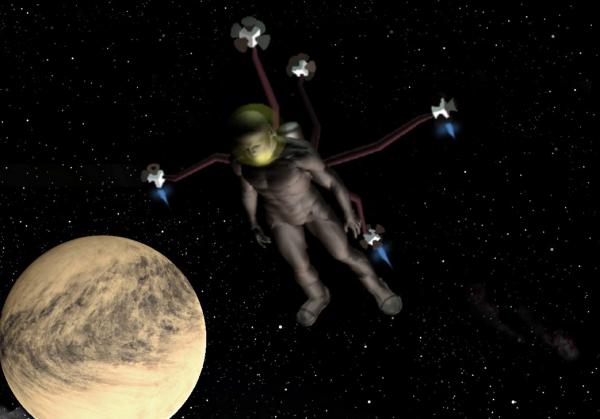BY LETTER
Thruster Pack
Technology > Technology Type or Material > Drytech/Hylotech
Technology > Application > Transportation > Interplanetary Transport
Technology > Technology Levels > Middle Tech / Midtech
Technology > Application > Transportation > Interplanetary Transport
Technology > Technology Levels > Middle Tech / Midtech
Compact propulsion unit used for individual operations in free-fall environments | |
 Image from Steve Bowers | |
| Thruster pack with thrust rig extended and effector frame retracted | |
A thruster pack consists of a limited function effector frame, two insulated fuel tanks of compressed nitrogen, a propulsion unit, and a control system. Fully fueled, an individual thruster pack unit masses 26 kg (dry weight 14 kg) and can support extra-vehicular activities averaging six hours in length on a single charge of propellant.
Effector Frame
While less capable than a standard frame, a thruster pack effector frame can extrude a number of grasping limbs of varying sizes to allow it to fit a wide range of users and bodyplans. This same capability gives thruster packs the ability to rearrange their propellant tanks to get through tight spaces, swap out exhausted propellant tanks, and attach themselves to objects of various sizes and shapes, turning the pack into a near universal small payload handler as required. Thruster pack systems will integrate seamlessly with full capability effector frames on command.Fuel Tanks
Thruster pack fuel tanks mass 6 kg each when fully charged, and contain compressed nitrogen as their default propellant. Smart matter valves and adaptive plumbing systems automatically reconfigure themselves to accommodate changes in thruster pack shape, handle different propellants (virtually any compressed, reasonably non-corrosive gas can be used), repair or reroute around punctures or damaged hardware, or transfer propellant from tank to tank, if required. If additional propellant tanks beyond the standard two are required, they need only be placed in contact with each other and the appropriate commands provided to seamlessly link together and combine individual plumbing and control systems into a unified whole.The exterior of each tank acts as a solar collector to keep the unit fully energized, although power can also be drawn from the user's space suit or from external energy sources (including other tanks) connected to the unit via beamed energy links, induction fields, or attached power cables. Each tank includes a smart matter layer that rapidly flows into place to close and seal any punctures that may be incurred by micrometeorites or other space debris.
Propulsion Unit
Thruster pack propulsion units are designed to reconfigure themselves based on the needs of their users. While designs may vary from place to place, a common configuration is a set of six spherical thrust units, each about 7 cm across and affixed to the end of a flexible smart matter 'tentacle' of about 1 meter in length at normal extension. Each tentacle is hollow and connects to the fuel tank plumbing system to transport fuel to its individual thruster unit. Each tentacle is self-repairing and can change length and position to fit into tight spaces, take over from a damaged thruster, or maximize thrust from a central point if required.Each thruster unit contains six individual thrust chambers, one on each face of an imaginary cube. When brought into contact with a fuel tentacle (and the appropriate commands given), a thruster unit will attach and form an airtight seal, while smart matter 'muscles' within the linked unit act as pumps and valves to control the flow and direction of the propellant gases. A linked thruster unit can fire in any of five directions and, if one or more thrusters on the unit becomes clogged or damaged, can briefly unseal from the fuel tentacle, which will extrude micro-limbs to rotate the unit until a working thrust chamber can be appropriately directed and the system can begin operating again, albeit in a reduced capacity. Entirely new thruster units can always be attached if needed and available, of course.
Propulsion units retract their tentacles when powered down or as needed and extend them in a hexagonal array as their default configuration.
Control System
Thruster pack control systems are designed to interface with a user's DNI and exoself. When first interfacing, the system downloads a set of control programs that allow the user to operate the thruster pack as though it were a direct extension of their own body. Users running the pack's program suite can mentally control each thruster unit individually or all units together, think in three dimensions, judge distances and angles with extreme accuracy, and experience neither disorientation nor discomfort due to a lack of a local vertical or when rotating on multiple axes, even at high speed. After the initial download, pack control programs can be retained in a user's exoself indefinitely and need not be downloaded again.Using their control systems, thruster packs can be operated by their individual user, by remote control, or by giving commands to their onboard sub-turing AI. Packs can operate with or without a user and can pilot themselves (and any attached cargo) to and from a given location, while carrying additional equipment, supplies, fresh fuel tanks, or whatever else is required.
Related Articles
Appears in Topics
Development Notes
Text by Todd Drashner
Initially published on 24 March 2015.
Initially published on 24 March 2015.






